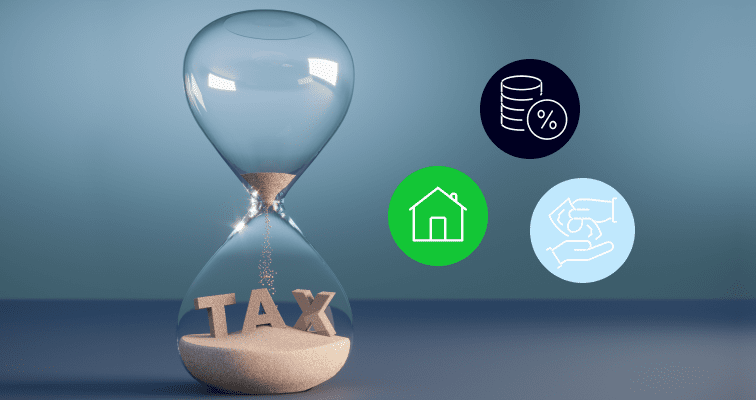When you sell assets, such as shares, you may need to pay capital gains tax (CGT). Find out what it is, how it works and what you need to know as an investor.
The process of investing is actually very simple. You use a platform like eToro to deposit your funds, choose the stock you want to invest in and then buy it. When you decide to sell, the process is just as straightforward. But after you’ve sold some or all of your shares — especially if you made a profit — there’s another step to the process: capital gains tax.
In Australia, if you buy stocks, property or other assets and then sell them at a higher price, the difference between the buy and sell price is called “capital gains”, and in many cases, the Australian Taxation Office requires that you pay tax on it.
This guide can help to make your investment journey easier, particularly when it comes to understanding CGT, how to calculate it and how you can potentially avoid it.
What is capital gains tax (CGT)?


Capital gains tax is a tax that you pay when you make a capital gain from the sale of shares, property or other assets. Having a “capital gain” means that you sold for a price higher than what you paid for it, whereas a capital loss means you sold for a price lower than what you paid for it.
It is your obligation to understand how capital gains tax works in Australia, as you may be liable for fines if you calculate your CGT incorrectly at tax time or fail to pay it at all.
The good news for investors is that the amount of capital gains tax that you end up paying will depend on a number of factors, such as how long you have owned the assets, your marginal tax rate, as well as whether you have accumulated any capital losses in the same tax period (which can reduce your overall tax obligations).
The length of time that you hold your shares before selling them is extremely important in the context of capital gains tax.
This is because if you have held them for more than 12 months and are an individual taxpayer, you will typically receive a 50% discount on CGT.
What assets have capital gains tax?

If you are concerned about how capital gains tax may affect your financial situation, it is important to know which assets are subject to CGT and which are exempt. While not an exhaustive list, you will usually have to pay capital gains tax if you make a profit on the sale of the following assets:
- Shares, units and similar investments
- Cryptoassets
- Real estate
- Personal use assets which cost more than $10,000 to purchase (e.g., boats, furniture, electrical items)
- Collectibles (e.g., artwork, jewellery, antiques)
- Foreign currency
- Intangible assets (e.g., contractual rights, licences, leases)
At the other end of the spectrum are assets which you can sell for a profit and not be liable to pay capital gains tax. As always, do your own research when you are selling an asset to make sure you do not have to pay tax.
CGT-exempt assets may include:
- Your main residence
- Cars, motorbikes and other vehicles
- Personal use assets which cost you less than $10,000
- Winnings from gambling and prizes
- Assets acquired before September 20, 1985
Be aware that if you sell an asset where CGT is applicable, it will trigger a CGT event and you will need to include the pertinent details in your tax return for that financial year.
If you buy and sell many shares throughout the year, it may be wise to get help from an experienced tax agent to make sure you don’t miss any of your CGT liabilities.
How does CGT impact my shares and other investments?

The most common CGT event is when you sell your shares — whether for a profit or a loss. However, there are separate instances where CGT can impact your other shares or investments. For example, if you:
- Redeem share units in a managed fund by switching them from one fund to another one.
- Make an in specie transfer, which involves transferring an asset in its current form rather than its monetary value.
- Choose to buy back your shares from the company.
- Receive a distribution from a unit trust or managed fund — this does not include dividend payouts.
- Receive payments from the company that are non-assessable.
- Hold shares during an acquisition or merger with another company.
- Hold shares when the company is liquidated or placed into administration — with your shares being declared worthless.
In terms of keeping records — which are extremely important come tax time — here is what you may need to maintain for all of the CGT assets you have acquired, according to the ATO:

Receipts of purchase or transfer

Details of interest on money you borrowed relating to the asset

Records of agent, accountant, legal and advertising costs

Receipts of insurance costs, rates and land taxes

Market valuations

Receipts of maintenance, repair and modification costs

Bank accounts showing brokerage fees on shares.
How do I calculate my CGT?
As capital gains tax can be complicated — especially when you are trying to calculate the CGT you are liable to pay across multiple assets during the same financial year — it is helpful to use a capital gains tax record-keeping tool. The ATO provides this and you can access it through your myGov account.
If you want to calculate your CGT obligations yourself, there are four key stages:
- Work out your “basis”: The purchase price of the asset plus any commissions or fees you paid. Don’t forget about reinvested dividends, which can increase the basis.
- Record your “realised amount”: This is simply the price you sold the asset for, less any fees or commissions you had to pay.
- Determine the difference: Subtract the “realised amount” from the “basis.” From here you will see whether you have a capital gain or a capital loss.
- Find out your tax rate: Short-term capital gains are considered ordinary income, so they can be taxed very highly, depending on your income bracket.
Tip: To pay less tax on your trades, hold your shares for at least a year before selling to receive a 50% discount on CGT.
How can I avoid paying capital gains tax on stocks?
While you may not be able to avoid paying capital gains tax entirely, you can deploy a few helpful strategies to minimise the amount of CGT you pay each financial year.
Hold for at least 12 months
Look to invest in long-term plays, rather than short-term investments, as holding the asset for over 12 months will usually give you a 50% discount on CGT once you sell it.
Take advantage of capital losses
You won’t win them all, so when you sell shares for a loss, you can use those capital losses to offset your capital gains.
Speak to a professional
A tax agent experienced with investment clients can give you individual advice on how to best reduce your CGT. While tax minimalisation is legal in Australia and even a sensible option, make sure that it doesn’t lead to tax avoidance, which can result in heavy fines from the ATO.
Capital gains tax is a necessary part of being an investor in Australia, so it is crucial that you familiarise yourself with CGT and know your obligations whenever tax time rolls around. Be sure to consult with a tax professional for advice relating to your individual circumstances — but in the meantime, enjoy your investment journey and don’t forget to keep records of every CGT asset you acquire!
Join eToro today and learn more about CGT, investing in shares and trading in general.
FAQs
- Do retirees pay capital gains tax in Australia?
-
Yes. It’s a common myth that retirees don’t have to pay CGT, but the truth is that there’s no age limit to paying capital gains tax in Australia.
- Do I pay capital gains tax if I sell my shares?
-
That depends on a variety of factors. If you have greater capital losses than capital gains during the financial year, for example, you may not have to pay capital gains tax.
- Can I sell stocks and reinvest without paying capital gains?
-
While some assets allow you to sell them and reinvest immediately to avoid capital gains, that doesn’t apply to stocks. A CGT event will be triggered every time you sell stocks.
This information is for educational purposes only and should not be taken as investment advice, personal recommendation, or an offer of, or solicitation to, buy or sell any financial instruments.
This material has been prepared without regard to any particular investment objectives or financial situation and has not been prepared in accordance with the legal and regulatory requirements to promote independent research. Not all of the financial instruments and services referred to are offered by eToro and any references to past performance of a financial instrument, index, or a packaged investment product are not, and should not be taken as, a reliable indicator of future results.
eToro makes no representation and assumes no liability as to the accuracy or completeness of the content of this guide. Make sure you understand the risks involved in trading before committing any capital. Never risk more than you are prepared to lose.


